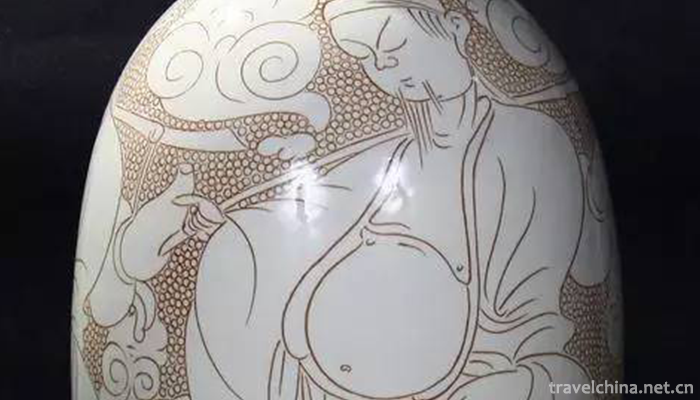Ceramic Firing Techniques of Dengfeng Kiln
Ceramic Firing Techniques of Dengfeng Kiln
Dengfeng kiln ceramics firing technology is a National Intangible Cultural Heritage Representative project. Historical records began in the Tang Dynasty and flourished in the Song Dynasty. It is well documented in the historical materials of Yuanfeng Jiuyu Zhi, Porcelain History, Supplementary Ancient and Modern Porcelain Origin, Ming Dynasty Henan Tongzhi, Qing Dynasty Taoshuo and Chinese Ceramics. The "Shenqian" of Dengfeng Kiln is connected with the mountain and water of Jun Porcelain, and its firing techniques reflect each other. Its products are in the shape of bowls, plates, bottles, pots, pots, pots, cupholders, cups, pillows, elephant animals and terracotta maids. The process of firing technology includes selection of raw materials, glaze processing, mud drilling, shaping, cosmetics, decoration, glazing, installation and firing, etc. The whole process of wet billet operation, one firing. The firing technique is characterized by distinct features, small or large shapes, with white porcelain as the main part and Pearl floral marking as the typical representative; the glaze is white, pure and bright; the decorative techniques are various, including traditional techniques such as delineation, delineation, mosaic and soft strokes. The finished product has a strong stereoscopic sense, and has important values of history, folklore, art, aesthetics, economy and so on.


-
1.Bosten Lake Scenic Area
Bosten Lake Scenic Spot is a national 5A scenic spot, covering an area of 988 square kilometers, is located in Xinjiang, China's scenic spots, Bosten Lake was known as the West Sea in ancient times,
Time 2018-12-12 -
2.Fuzhou national forest park
Fuzhou National Forest Park (also known as "Fuzhou Botanical Garden") is the first National Forest Park in Fujian Province, one of the ten National Forest parks, and one of the six 4A scenic
Time 2019-01-12 -
3.Strange slope Scenic Area
Weipo Scenic Spot is located at the foot of Maoshan Mountain in Qingshuitai Town, Xinchengzi District, Shenyang City, Liaoning Province, facing the wilderness, backed by mountains
Time 2019-01-12 -
4.Jiangwan Scenic Area of Wuyuan
Jiangwan Scenic Area is located in the northeast of Wuyuan County, Jiangxi Province, Shangrao City. It is an ancient village with rich Huizhou culture. Up to now, the village has preserved a large num
Time 2019-01-21 -
5.Scissors Forging Technology
Zhang Xiaoquan scissors forging technology, local traditional handicraft in Hangzhou, Zhejiang Province, one of the national intangible cultural heritage.
Time 2019-05-05 -
6.Glass Firing Techniques
Glass firing technology, Beijing Mentougou District, Shanxi Province, local traditional handicraft, one of the national intangible cultural heritage.
Time 2019-05-14 -
7.Uygur Residential Architecture Skills Aiwan Sailai Residential Construction Skills
Uygur Aiwan Sailai dwellings are mainly distributed in towns and villages along the desert edge of the Tarim Basin, especially in Yutian, Moyu, Minfeng, Pishan, Hetian, Shache and Kashgar along the so
Time 2019-06-26 -
8.conjuring tricks
Conjuring tricks is one of the traditional Chinese acrobatics. Performers use agile methods to create audiovisual illusions, performing various objects, animals or water and fire and other rapid incre
Time 2019-07-01 -
9.Yazhou Folk Songs
Yazhou folk song is one of the ancient folk songs in Hainan Province. It is popular in the areas of Yazhou and Dongfangkangcheng, west of Sanya Yacheng and east coast of Ledong. Yazhou Guest (Han) dia
Time 2019-07-10 -
10.Calculation with an abacus
Liu Hong (129-210 A.D.), a character Zhuo, a descendant of Liu Xing, the king of Lu in the Eastern Han Dynasty, is an outstanding astronomer and mathematician in ancient China. He is the inventor of a
Time 2019-08-10 -
11.Ding Zhen from the plateau Village
The 20-year-old Tibetan boy is from a small mountain village in Litang County, Ganzi Tibetan Autonomous Prefecture, Sichuan Province. More than 20 days ago, a photographer released a short video on the short video platform, which made Ding Zhen
Time 2020-12-07 -
12.Yibin secondary industry
In 2019, the total industrial added value of Yibin City is 99.082 billion yuan, an increase of 9.5% over the previous year, and its contribution rate to economic growth is 45.5%. At the end of the year, there were 824 Industrial Enterprises above Designated Si
Time 2020-12-18